Nothing beats the thrill of spicing up your dinner routine with bold, vibrant flavors, and our collection of 18 Spicy Asian Vegetable Recipes is here to do just that! Perfect for home cooks looking to add a little heat and a lot of veggies to their meals, these dishes promise to delight your taste buds and inspire your culinary adventures. Ready to turn up the heat? Let’s dive in!
Stir-Fried Bok Choy with Garlic
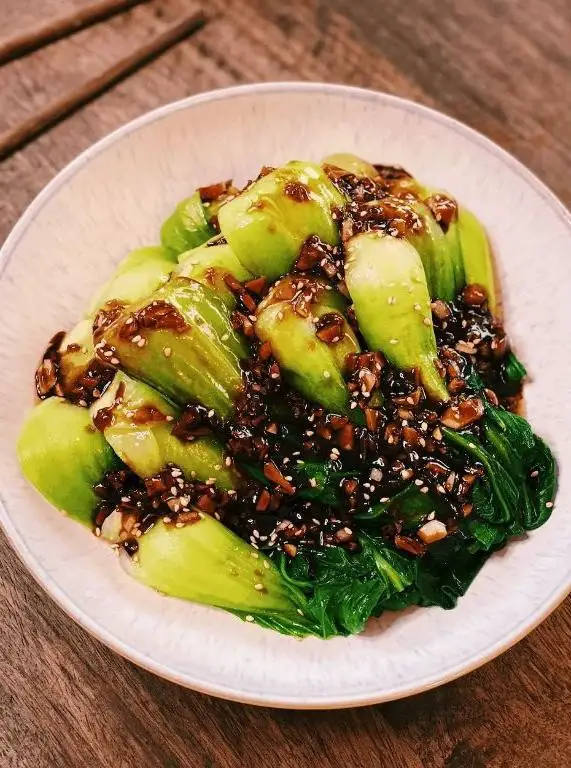
Here’s a little secret from my kitchen to yours: stir-fried bok choy with garlic is my go-to side dish when I need something quick, healthy, and bursting with flavor. I remember the first time I made it, skeptical about how such simple ingredients could create something so delicious, but one bite was all it took to convince me.
Ingredients
- Bok choy – 1 lb
- Garlic – 3 cloves, minced
- Olive oil – 2 tbsp
- Salt – ½ tsp
Instructions
- Wash the bok choy thoroughly under cold water, then pat dry with a clean towel. Tip: Ensuring your bok choy is dry helps it crisp up nicely when stir-fried.
- Heat olive oil in a large skillet over medium-high heat until shimmering, about 1 minute.
- Add minced garlic to the skillet, stirring constantly for about 30 seconds until fragrant. Tip: Keep the garlic moving to prevent it from burning.
- Add the bok choy to the skillet, tossing to coat it evenly with the garlic and oil.
- Sprinkle salt over the bok choy, then stir-fry for 3-4 minutes until the leaves are wilted and the stems are tender-crisp. Tip: Don’t overcrowd the skillet; cook in batches if necessary for the best texture.
Now, this dish is all about the contrast between the crisp stems and the tender leaves, with the garlic adding a punchy depth of flavor. I love serving it alongside grilled chicken or tossing it with noodles for a quick vegetarian meal.
Spicy Szechuan Green Beans

Just last week, I found myself staring at a bundle of fresh green beans at the farmers’ market, and it hit me—why not spice things up a bit? That’s how this Spicy Szechuan Green Beans recipe came to life, a dish that’s as fiery as it is flavorful, perfect for those who love a little heat in their meals.
Ingredients
- Green beans – 1 lb
- Soy sauce – 2 tbsp
- Szechuan peppercorns – 1 tsp
- Garlic – 3 cloves, minced
- Red pepper flakes – 1 tsp
- Vegetable oil – 2 tbsp
Instructions
- Wash the green beans thoroughly and pat them dry with a paper towel to ensure they crisp up nicely when cooked.
- Heat the vegetable oil in a large skillet over medium-high heat until it shimmers, about 2 minutes. Tip: A well-heated pan is key to getting that perfect sear on the beans.
- Add the green beans to the skillet, spreading them out in a single layer. Cook for 5 minutes without stirring to allow them to blister and char slightly.
- Stir in the minced garlic, Szechuan peppercorns, and red pepper flakes, cooking for another 2 minutes until fragrant. Tip: Keep the garlic moving to prevent it from burning.
- Pour in the soy sauce, tossing the beans to coat evenly. Cook for an additional 1 minute, then remove from heat. Tip: The soy sauce will reduce quickly, so keep an eye on it to avoid over-reducing.
Crisp on the outside with a tender bite, these Spicy Szechuan Green Beans pack a punch with every forkful. Serve them alongside steamed rice to balance the heat, or toss them into a noodle bowl for an extra layer of texture and flavor.
Thai Basil Eggplant Stir Fry
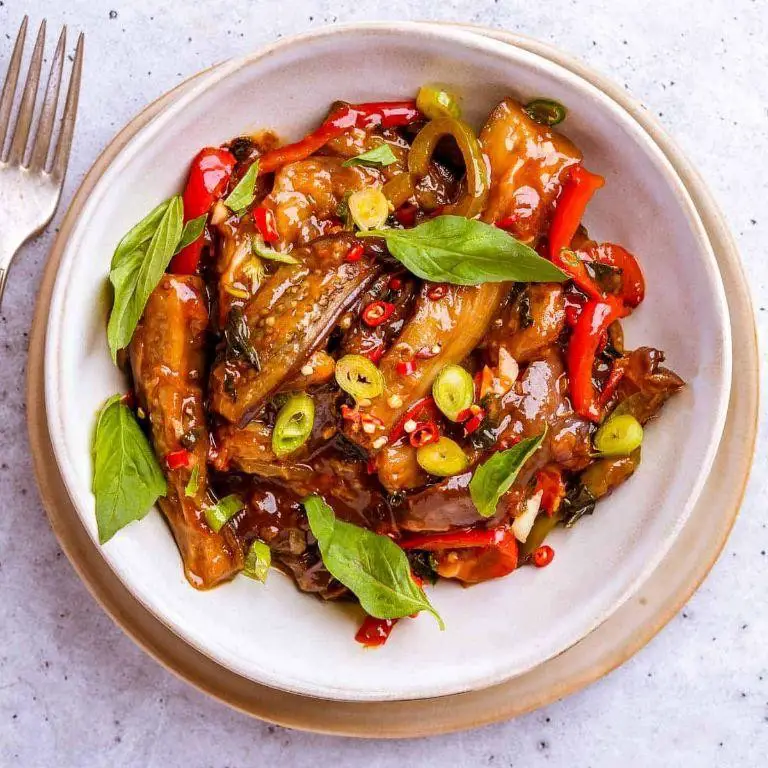
Finally, after a long day, I found myself craving something both comforting and exciting—enter Thai Basil Eggplant Stir Fry. It’s a dish that reminds me of my first trip to Thailand, where the vibrant flavors and aromas instantly won me over. Now, I make it at home whenever I need a quick, flavorful escape.
Ingredients
- Eggplant – 2 cups, cubed
- Thai basil – 1 cup, packed
- Garlic – 3 cloves, minced
- Soy sauce – 2 tbsp
- Vegetable oil – 2 tbsp
- Red chili flakes – 1 tsp
Instructions
- Heat vegetable oil in a large pan over medium-high heat (350°F) until shimmering.
- Add minced garlic and red chili flakes, sautéing for 30 seconds until fragrant but not browned.
- Toss in cubed eggplant, stirring to coat with oil. Cook for 5 minutes, stirring occasionally.
- Pour soy sauce over the eggplant, mixing well. Cover and reduce heat to medium (300°F), cooking for another 10 minutes until eggplant is tender.
- Tip: If the pan gets too dry, add a splash of water to prevent sticking.
- Remove from heat and fold in Thai basil leaves until just wilted.
- Tip: For extra flavor, tear the basil leaves instead of chopping them to release more aroma.
- Serve immediately over steamed rice or noodles.
- Tip: Garnish with extra basil leaves and a sprinkle of chili flakes for a beautiful presentation.
Velvety eggplant pieces soak up the savory soy sauce, while the Thai basil adds a fresh, peppery kick. I love serving this stir fry with a side of crispy tofu to round out the meal.
Korean Spicy Cucumber Salad
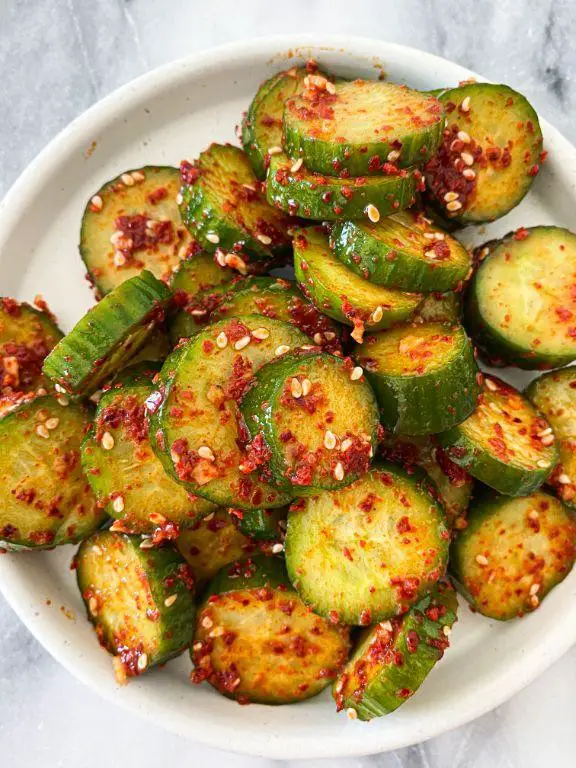
This summer, I found myself craving something crunchy, spicy, and refreshing to beat the heat, and that’s when I stumbled upon this Korean Spicy Cucumber Salad. It’s become my go-to side dish for BBQs and potlucks, and I love how it brings a burst of flavor to any meal.
Ingredients
- Cucumbers – 2 large
- Salt – 1 tsp
- Sugar – 1 tbsp
- Garlic – 2 cloves, minced
- Gochugaru (Korean red pepper flakes) – 1 tbsp
- Sesame oil – 1 tbsp
- Rice vinegar – 1 tbsp
- Sesame seeds – 1 tsp
Instructions
- Wash the cucumbers thoroughly and slice them into thin rounds. Tip: Leaving the skin on adds a nice crunch and color.
- Place the cucumber slices in a large bowl and sprinkle with salt. Let them sit for 10 minutes to draw out excess water.
- After 10 minutes, rinse the cucumbers under cold water and pat dry with a paper towel. Tip: This step ensures your salad isn’t watery.
- In the same bowl, combine the cucumbers with sugar, minced garlic, gochugaru, sesame oil, and rice vinegar. Mix well until all the cucumbers are evenly coated. Tip: Adjust the amount of gochugaru based on your spice preference.
- Sprinkle sesame seeds over the top and give it one final gentle toss.
Just like that, you’ve got a vibrant, spicy, and slightly sweet cucumber salad that’s perfect alongside grilled meats or as a standalone snack. The sesame oil and seeds add a nutty depth that complements the heat beautifully. Try serving it chilled for an extra refreshing bite!
Vietnamese Lemongrass Tofu with Vegetables
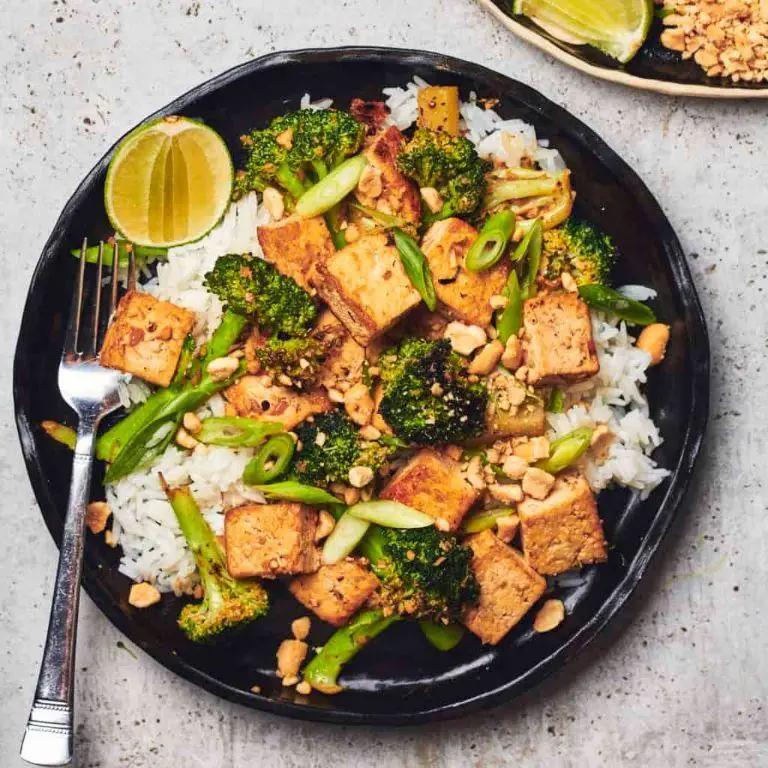
Sometimes, the simplest dishes bring the most comfort, and this Vietnamese Lemongrass Tofu with Vegetables is no exception. I stumbled upon this recipe during a rainy afternoon when all I wanted was something light yet flavorful, and it’s been a staple in my kitchen ever since.
Ingredients
- Firm tofu – 14 oz
- Lemongrass – 2 stalks
- Soy sauce – 2 tbsp
- Vegetable oil – 1 tbsp
- Broccoli – 1 cup
- Carrots – 1 cup
Instructions
- Press the tofu for 30 minutes to remove excess water, then cut into 1-inch cubes.
- Finely chop the lemongrass, using only the tender inner parts of the stalk.
- Heat vegetable oil in a pan over medium heat (350°F) and add the tofu. Cook until all sides are golden brown, about 5 minutes per side.
- Add the chopped lemongrass to the pan and stir for 1 minute until fragrant.
- Pour in the soy sauce and stir to coat the tofu evenly.
- Add the broccoli and carrots to the pan, stirring occasionally, until the vegetables are tender but still crisp, about 5 minutes.
- Tip: For extra flavor, marinate the tofu in soy sauce and lemongrass for an hour before cooking.
- Tip: Always use fresh lemongrass for the best aroma and taste.
- Tip: Don’t overcrowd the pan to ensure the tofu gets crispy.
Now, the tofu is wonderfully crispy on the outside and soft inside, with the lemongrass adding a refreshing zing. Serve it over steamed rice or alongside a fresh salad for a complete meal.
Japanese Ginger Carrot Salad

Never underestimate the power of a simple salad to brighten up your day, especially when it’s as vibrant and flavorful as this Japanese Ginger Carrot Salad. I stumbled upon this recipe during a chilly autumn evening when I was craving something light yet satisfying, and it’s been a staple in my kitchen ever since.
Ingredients
- Carrots – 2 cups, grated
- Rice vinegar – 2 tbsp
- Soy sauce – 1 tbsp
- Sesame oil – 1 tsp
- Fresh ginger – 1 tbsp, minced
- Sesame seeds – 1 tbsp
Instructions
- In a large bowl, combine the grated carrots, rice vinegar, soy sauce, sesame oil, and minced ginger. Tip: For the best flavor, let the salad sit for at least 10 minutes before serving to allow the flavors to meld.
- Toss the salad well to ensure all the ingredients are evenly coated with the dressing. Tip: Use your hands to toss the salad gently to prevent the carrots from becoming too mushy.
- Sprinkle the sesame seeds over the top of the salad just before serving. Tip: Toasting the sesame seeds lightly in a dry pan before adding them to the salad can enhance their nutty flavor.
The crunch of the fresh carrots paired with the zingy ginger and the nutty sesame seeds makes this salad a delightful side dish or a light meal on its own. Try serving it alongside grilled fish or chicken for a complete meal that’s bursting with flavor.
Chinese Garlic Broccoli

Over the years, I’ve found that the simplest dishes often bring the most comfort, especially when they’re packed with flavor like this Chinese Garlic Broccoli. It’s a quick, healthy side that turns any meal into something special, and it’s become a staple in my kitchen for busy weeknights.
Ingredients
- Broccoli – 1 lb
- Garlic – 3 cloves, minced
- Soy sauce – 2 tbsp
- Olive oil – 1 tbsp
- Water – ¼ cup
Instructions
- Wash the broccoli thoroughly under cold water, then cut into florets.
- Heat olive oil in a large skillet over medium-high heat until shimmering, about 1 minute. Tip: The oil should be hot enough to sizzle when broccoli is added.
- Add the broccoli florets to the skillet, stirring occasionally, until they start to turn bright green, about 2 minutes.
- Add the minced garlic to the skillet, stirring constantly to prevent burning, about 30 seconds. Tip: Garlic burns quickly, so keep an eye on it!
- Pour in the water and soy sauce, then cover the skillet with a lid. Reduce heat to medium and let steam for 3 minutes. Tip: Steaming the broccoli after sautéing ensures it’s tender but still crisp.
- Remove the lid and continue to cook, stirring occasionally, until the liquid has mostly evaporated and the broccoli is tender, about 2 more minutes.
Vibrant and full of flavor, this Chinese Garlic Broccoli is perfectly crisp-tender with a savory garlicky sauce that clings to every floret. Serve it alongside grilled chicken or tofu for a complete meal, or enjoy it as is for a light, healthy snack.
Indian Spiced Cauliflower Curry

Finally, a dish that brings the warmth of Indian spices into my kitchen without the fuss! I stumbled upon this Indian Spiced Cauliflower Curry during a lazy Sunday experiment, and it’s been a staple ever since. It’s the perfect blend of simplicity and flavor, especially when you’re craving something hearty yet healthy.
Ingredients
- Cauliflower – 1 medium head, cut into florets
- Olive oil – 2 tbsp
- Onion – 1, diced
- Garlic – 3 cloves, minced
- Ginger – 1 tbsp, grated
- Tomato – 1, chopped
- Turmeric – 1 tsp
- Cumin – 1 tsp
- Coriander – 1 tsp
- Salt – ½ tsp
- Water – 1 cup
- Cilantro – for garnish
Instructions
- Heat olive oil in a large pan over medium heat (350°F). Tip: Ensure the oil is hot but not smoking to avoid burning the spices.
- Add diced onion, sauté until translucent, about 5 minutes.
- Stir in minced garlic and grated ginger, cook for another minute until fragrant.
- Add chopped tomato, cook until it softens, about 3 minutes. Tip: A pinch of salt here helps break down the tomatoes faster.
- Mix in turmeric, cumin, coriander, and salt, stir well to combine with the onion mixture.
- Add cauliflower florets, toss to coat evenly with the spice mixture.
- Pour in water, bring to a simmer, then cover and cook for 15 minutes, or until cauliflower is tender. Tip: Check halfway through to ensure there’s enough liquid; add a splash more water if needed.
- Garnish with fresh cilantro before serving.
The curry turns out wonderfully aromatic, with the cauliflower soaking up all the spices while retaining a slight crunch. Serve it over a bed of fluffy basmati rice or with warm naan for a complete meal that’s sure to impress.
Malaysian Sambal Okra
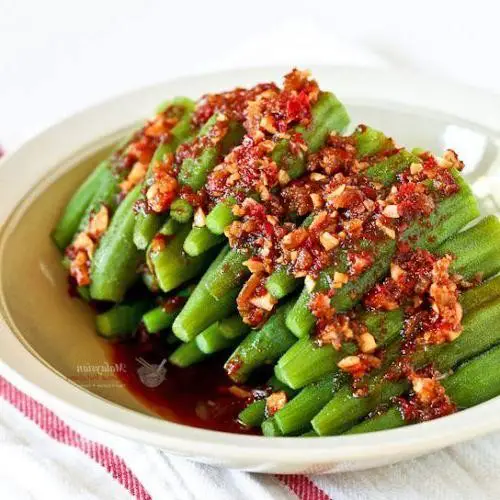
This weekend, I stumbled upon a bunch of fresh okra at my local farmer’s market, and it instantly reminded me of the spicy, tangy Malaysian Sambal Okra I had on my last trip to Kuala Lumpur. Determined to recreate that vibrant dish at home, I tweaked my usual sambal recipe to let the okra shine.
Ingredients
- Okra – 1 lb
- Sambal oelek – 2 tbsp
- Garlic – 3 cloves, minced
- Vegetable oil – 2 tbsp
- Salt – ½ tsp
Instructions
- Wash the okra under cold water and pat dry thoroughly to prevent splattering when frying.
- Heat vegetable oil in a large skillet over medium-high heat until shimmering, about 2 minutes.
- Add minced garlic to the skillet, sautéing for 30 seconds until fragrant but not browned.
- Stir in sambal oelek and cook for another minute to release its flavors.
- Add the okra to the skillet, tossing to coat evenly with the sambal mixture.
- Reduce heat to medium, cover, and cook for 10 minutes, stirring occasionally to prevent sticking.
- Uncover, sprinkle with salt, and continue cooking for another 5 minutes until the okra is tender and the edges are slightly crispy.
So, the Malaysian Sambal Okra turns out beautifully with a sticky, slightly crispy texture that contrasts wonderfully with the spicy, umami-rich sambal. Serve it over steamed jasmine rice or alongside grilled fish for a complete meal that transports you straight to the streets of Malaysia.
Filipino Adobo Eggplant
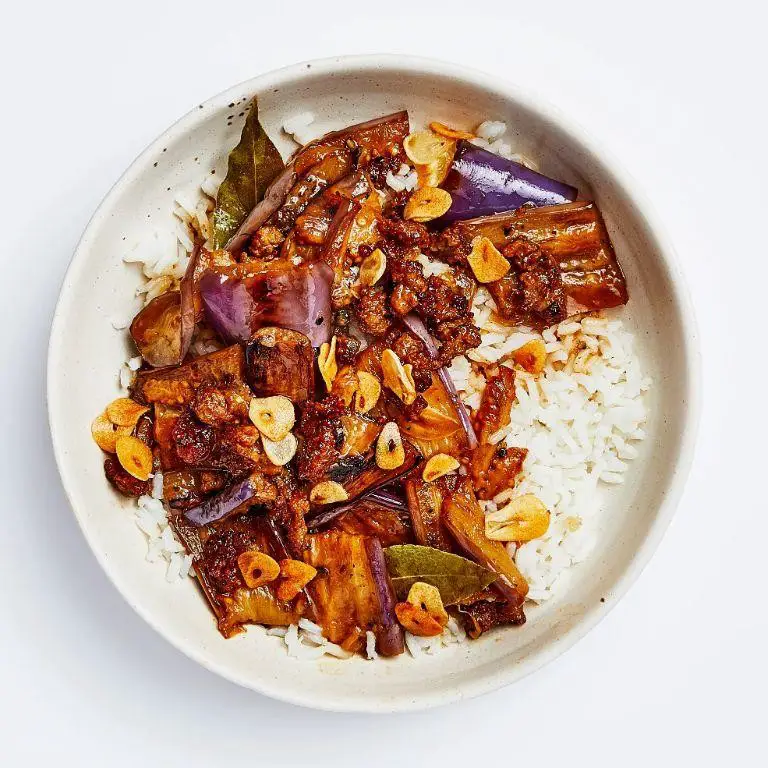
Craving something savory with a twist? I recently stumbled upon this Filipino Adobo Eggplant recipe during a late-night cooking experiment, and it’s been a game-changer for my weeknight dinners. It’s a simple, flavorful dish that brings a comforting taste of the Philippines right to your kitchen.
Ingredients
- Eggplant – 2 medium, sliced into rounds
- Soy sauce – ¼ cup
- Vinegar – ¼ cup
- Garlic – 4 cloves, minced
- Bay leaves – 2
- Black peppercorns – 1 tsp
- Water – ½ cup
Instructions
- In a large pan, combine soy sauce, vinegar, minced garlic, bay leaves, and black peppercorns. Tip: Letting the sauce sit for a few minutes before cooking enhances the flavors.
- Add the sliced eggplant to the pan, ensuring each piece is coated with the sauce. Tip: Don’t overcrowd the pan to allow even cooking.
- Pour in water, then bring the mixture to a boil over medium-high heat.
- Once boiling, reduce the heat to low, cover, and simmer for 15 minutes. Tip: Check occasionally to prevent the sauce from drying out too quickly.
- After 15 minutes, uncover and cook for another 5 minutes to slightly thicken the sauce.
- Remove from heat and let it sit for 2 minutes before serving.
The eggplant turns wonderfully tender, soaking up all the tangy, garlicky adobo sauce. Try serving it over a bed of steamed rice for a hearty meal that’s bursting with flavor.
Singaporean Chili Pepper Tofu

Every time I stumble upon a dish that’s both fiery and comforting, I can’t help but dive into its creation headfirst. That’s exactly how I felt when I first tried Singaporean Chili Pepper Tofu—a dish that’s as vibrant in flavor as it is in color. It’s become a staple in my kitchen, especially on those days when I crave something that packs a punch but doesn’t skimp on the comfort factor.
Ingredients
- Firm tofu – 14 oz
- Vegetable oil – 2 tbsp
- Garlic – 3 cloves, minced
- Red chili peppers – 2, sliced
- Soy sauce – 2 tbsp
- Sugar – 1 tsp
- Water – ¼ cup
Instructions
- Press the tofu for 15 minutes to remove excess water, then cut into 1-inch cubes.
- Heat vegetable oil in a pan over medium-high heat until shimmering, about 1 minute.
- Add tofu cubes in a single layer, frying until golden brown on all sides, about 3 minutes per side. Tip: Don’t overcrowd the pan to ensure even browning.
- Remove tofu and set aside. In the same pan, add minced garlic and sliced chili peppers, sautéing for 1 minute until fragrant.
- Return tofu to the pan, adding soy sauce, sugar, and water. Stir gently to combine.
- Simmer on low heat for 5 minutes, allowing the tofu to absorb the flavors. Tip: Covering the pan helps infuse the tofu more deeply.
- Once the sauce thickens slightly, remove from heat. Tip: Let it sit for 2 minutes off the heat for the flavors to meld beautifully.
Perfectly balanced between spicy and sweet, this dish offers a delightful contrast of crispy tofu edges with a soft, sauce-soaked center. Serve it over steamed rice or alongside stir-fried vegetables for a meal that’s as satisfying as it is simple to make.
Indonesian Gado-Gado Vegetable Salad

Believe it or not, my first encounter with Gado-Gado was at a tiny food stall during a rainstorm in Jakarta. The vibrant colors and the peanut sauce’s aroma were irresistible. Since then, I’ve been making my version at home, tweaking it to perfection.
Ingredients
- Green beans – 1 cup
- Cabbage – 2 cups, shredded
- Potatoes – 2, medium, boiled and cubed
- Eggs – 2, hard-boiled
- Peanut butter – ½ cup
- Soy sauce – 2 tbsp
- Brown sugar – 1 tbsp
- Lime juice – 1 tbsp
- Water – ¼ cup
Instructions
- Blanch the green beans in boiling water for 2 minutes, then plunge into ice water to stop the cooking.
- In a large bowl, combine the blanched green beans, shredded cabbage, and cubed potatoes.
- Slice the hard-boiled eggs and arrange them on top of the vegetables.
- In a small saucepan over low heat, whisk together peanut butter, soy sauce, brown sugar, lime juice, and water until smooth and heated through, about 5 minutes.
- Pour the warm peanut sauce over the salad just before serving.
So, there you have it—a salad that’s as fun to say as it is to eat. The crunch of the vegetables against the creamy, tangy peanut sauce is a texture dream. Try serving it with a side of crispy prawn crackers for an extra crunch.
Thai Green Papaya Salad

After my first bite of Thai Green Papaya Salad at a bustling street market in Bangkok, I was hooked. The crunch, the heat, the tang—it was love at first taste. Now, I make it at home whenever I crave something fresh and fiery, and today, I’m sharing my go-to recipe with you.
Ingredients
- Green papaya – 1 medium, shredded
- Garlic – 2 cloves
- Thai chilies – 2, adjust to taste
- Fish sauce – 2 tbsp
- Lime – 1, juiced
- Palm sugar – 1 tbsp
- Cherry tomatoes – 5, halved
- Green beans – 5, cut into 1-inch pieces
- Peanuts – ¼ cup, roasted and crushed
Instructions
- Peel and shred the green papaya into thin strips using a julienne peeler or a knife.
- In a mortar, pound the garlic and Thai chilies into a rough paste. Tip: Wear gloves when handling chilies to avoid skin irritation.
- Add the palm sugar, fish sauce, and lime juice to the mortar. Stir until the sugar dissolves. Tip: Adjust the balance of sweet, sour, and salty to your liking by tweaking these ingredients.
- Toss the shredded papaya, cherry tomatoes, and green beans in a large bowl with the dressing from the mortar.
- Mix well until all the ingredients are evenly coated with the dressing. Tip: Let the salad sit for 10 minutes before serving to allow the flavors to meld.
- Sprinkle the crushed peanuts on top just before serving.
The salad is a vibrant mix of crunchy papaya and beans, softened slightly by the dressing, with a punch of heat and a hint of sweetness. Serve it alongside grilled meats or as a standalone dish for a light, refreshing meal.
Korean Kimchi Pancakes with Vegetables

Remember those lazy Sunday mornings when you crave something savory yet easy to whip up? That’s exactly how I stumbled upon making these Korean Kimchi Pancakes with Vegetables. It’s become my go-to for a quick, flavorful meal that never fails to impress.
Ingredients
- Flour – 1 cup
- Water – ¾ cup
- Egg – 1
- Kimchi – 1 cup, chopped
- Vegetable oil – 2 tbsp
- Salt – ½ tsp
Instructions
- In a large bowl, whisk together flour, water, egg, and salt until smooth.
- Fold in the chopped kimchi gently to avoid breaking it apart too much.
- Heat 1 tbsp of vegetable oil in a non-stick skillet over medium heat (350°F).
- Pour half of the batter into the skillet, spreading it evenly to form a pancake.
- Cook for 3-4 minutes until the edges start to crisp and the bottom is golden brown.
- Flip the pancake carefully and cook the other side for another 3-4 minutes.
- Repeat with the remaining batter, adding the rest of the oil to the skillet.
- Transfer the pancakes to a cutting board and slice into wedges before serving.
Soaking up the crispy edges with the soft, tangy center of these pancakes is pure bliss. Serve them with a side of soy sauce mixed with a bit of vinegar for an extra kick, or enjoy them as is for a quick snack.
Chinese Hot and Sour Cabbage
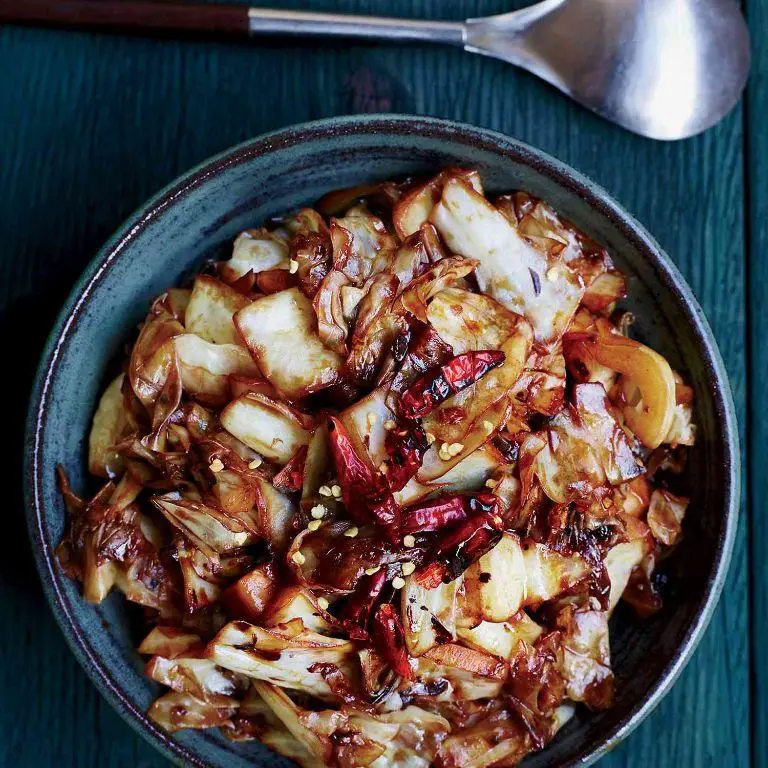
Whenever I’m craving something tangy and spicy, Chinese Hot and Sour Cabbage is my go-to dish. It’s a simple yet flavorful recipe that reminds me of the bustling night markets in Beijing, where the aroma of spices fills the air.
Ingredients
- Cabbage – 1 small head
- White vinegar – 3 tbsp
- Soy sauce – 2 tbsp
- Sugar – 1 tsp
- Red pepper flakes – 1 tsp
- Vegetable oil – 2 tbsp
Instructions
- Wash the cabbage thoroughly under cold water, then pat dry with a clean towel.
- Cut the cabbage into 2-inch pieces, discarding the tough core.
- Heat vegetable oil in a large wok or skillet over medium-high heat until shimmering, about 1 minute.
- Add the cabbage to the wok, stirring constantly for 3 minutes until it begins to soften.
- In a small bowl, mix white vinegar, soy sauce, sugar, and red pepper flakes until the sugar dissolves.
- Pour the sauce over the cabbage, stirring to coat evenly. Cook for another 2 minutes.
- Reduce the heat to low, cover the wok, and let the cabbage simmer for 5 minutes to absorb the flavors.
- Uncover and increase the heat to medium-high, stirring for 1 minute to evaporate any excess liquid.
Last but not least, this dish offers a delightful crunch with a perfect balance of heat and tang. Serve it alongside steamed rice or as a vibrant topping for your favorite protein to elevate any meal.
Japanese Miso Glazed Eggplant
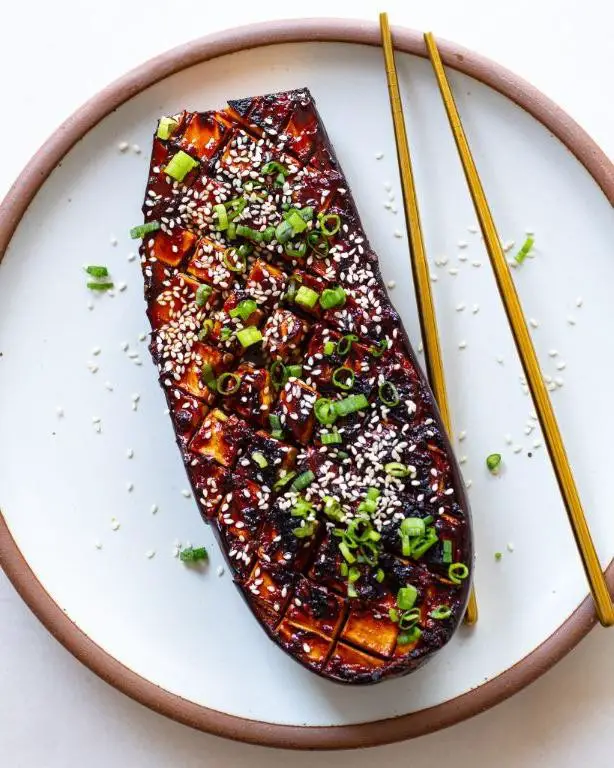
Recently, I stumbled upon a dish that has since become a staple in my kitchen: Japanese Miso Glazed Eggplant. It’s a simple yet flavorful dish that brings a touch of umami to any meal, and I love how it combines the earthiness of eggplant with the rich, savory depth of miso.
Ingredients
- Eggplant – 2 medium
- White miso paste – 3 tbsp
- Mirin – 2 tbsp
- Sugar – 1 tbsp
- Sesame oil – 1 tbsp
- Water – ¼ cup
Instructions
- Preheat your oven to 400°F (200°C) and line a baking sheet with parchment paper.
- Cut the eggplants in half lengthwise and score the flesh in a crisscross pattern to help the glaze penetrate.
- Brush the eggplant halves with sesame oil and place them cut-side up on the prepared baking sheet.
- Roast in the preheated oven for 20 minutes, or until the flesh starts to soften.
- While the eggplants are roasting, whisk together the miso paste, mirin, sugar, and water in a small bowl until smooth.
- After 20 minutes, remove the eggplants from the oven and brush the miso glaze evenly over the cut sides.
- Return to the oven and roast for another 10 minutes, or until the glaze is bubbly and the eggplants are tender.
- For a caramelized finish, broil for the last 2-3 minutes, watching closely to prevent burning.
Absolutely divine, the miso glaze caramelizes into a sticky, sweet, and savory coating that contrasts beautifully with the creamy eggplant. Serve it as a side dish or over a bowl of steamed rice for a simple, satisfying meal.
Vietnamese Fresh Spring Rolls with Vegetables

Every time I think about Vietnamese Fresh Spring Rolls, I’m transported back to a tiny street vendor in Hanoi, where I first fell in love with their crisp, fresh flavors. Making them at home has become a summer ritual for me, especially when I’m craving something light yet satisfying.
Ingredients
- Rice paper wrappers – 8
- Vermicelli noodles – 1 cup
- Carrots – 1, julienned
- Cucumber – 1, julienned
- Fresh mint leaves – ½ cup
- Fresh cilantro – ½ cup
- Lime – 1, juiced
- Peanut butter – 2 tbsp
- Soy sauce – 1 tbsp
- Water – ¼ cup
Instructions
- Fill a large bowl with warm water. Dip one rice paper wrapper into the water for 5 seconds until soft. Lay it flat on a clean surface.
- Place a small handful of vermicelli noodles in the center of the wrapper, leaving about 2 inches uncovered on each side.
- Add a few strips of carrot and cucumber on top of the noodles.
- Sprinkle mint and cilantro leaves over the vegetables.
- Fold the sides of the wrapper over the filling, then roll tightly from the bottom to the top. Tip: Keep the filling compact to prevent tearing.
- Repeat with the remaining wrappers and filling.
- In a small bowl, whisk together lime juice, peanut butter, soy sauce, and water until smooth for the dipping sauce. Tip: Adjust the water to achieve your desired sauce consistency.
- Serve the spring rolls immediately with the dipping sauce. Tip: For extra crunch, add a few crushed peanuts to the sauce.
Vietnamese Fresh Spring Rolls with Vegetables are a delightful mix of textures, from the soft rice paper to the crunchy vegetables inside. They’re perfect for a light lunch or as an appetizer at your next gathering. Try serving them with a side of spicy sriracha for an extra kick!
Indian Aloo Gobi
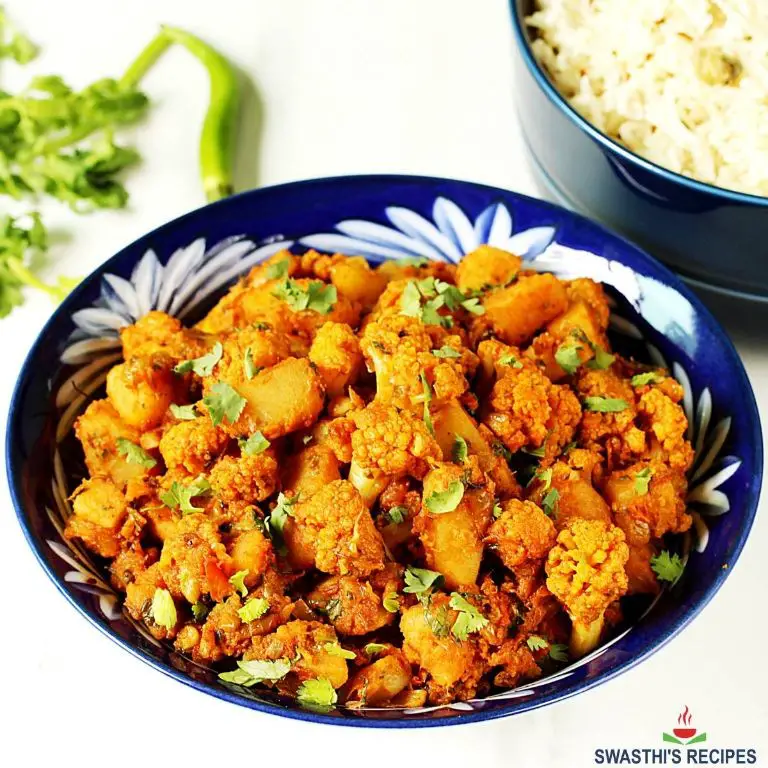
Unbelievably simple yet packed with flavor, Indian Aloo Gobi has been my go-to comfort dish on busy weeknights. It’s a humble combination of potatoes and cauliflower that transforms into something magical with the right spices. I remember the first time I made it, skeptical about how such few ingredients could deliver so much taste, but one bite was all it took to convince me.
Ingredients
- Potatoes – 2 cups, cubed
- Cauliflower – 2 cups, florets
- Vegetable oil – 2 tbsp
- Cumin seeds – 1 tsp
- Turmeric powder – ½ tsp
- Salt – 1 tsp
- Garam masala – 1 tsp
- Fresh cilantro – 2 tbsp, chopped
Instructions
- Heat vegetable oil in a large pan over medium heat (350°F).
- Add cumin seeds and wait until they sizzle, about 30 seconds, to release their aroma.
- Add cubed potatoes and sauté for 5 minutes, stirring occasionally to prevent sticking.
- Add cauliflower florets, turmeric powder, and salt. Mix well to coat the vegetables evenly.
- Cover the pan and cook for 15 minutes, stirring every 5 minutes, until the vegetables are tender.
- Sprinkle garam masala over the cooked vegetables and stir to combine.
- Garnish with fresh cilantro before serving.
Delightfully tender potatoes and cauliflower absorb the earthy spices, creating a dish that’s both comforting and vibrant. Serve it alongside warm rotis or over a bed of basmati rice for a fulfilling meal. The key is the garam masala added at the end, which brings a warm depth to the dish without overpowering the natural flavors of the vegetables.
Conclusion
Whether you’re craving a fiery stir-fry or a comforting bowl of spicy noodles, our roundup of 18 Spicy Asian Vegetable Recipes offers something to delight every palate. These dishes are not just about turning up the heat; they’re a celebration of vibrant flavors and wholesome ingredients. We’d love for you to try them out, share your favorites in the comments, and spread the love by pinning this article on Pinterest!

Michael Johnson is the founder of Pan Mastery, Inspired by his blacksmith grandfather’s legacy has a deep appreciation for hand-crafted pots and pans, he provides invaluable guides, reviews, and recipes to enhance your culinary journey.
